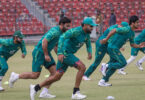LONDON (Agencies): As a boy, when I was learning how to play and understand cricket, it was drummed into me by my seniors that the umpire’s decision was final. I witnessed and suffered what appeared to be poor or biased decisions by umpires who made me question the veracity of this mantra.
In the league in which I cut my teeth, neutral umpires were appointed, but it seemed that some of them carried baggage about certain clubs and individuals from prior encounters. One incident which has stuck with me occurred in a match between my local town club and a fierce local rival. Whilst I was batting, the opponents appealed for a catch by the wicket keeper. As I was sure that I hit the ball, I “walked,” not waiting for the umpire’s decision.
On my way back to the pavilion, I was met by my captain, who, pointing behind, said, in strong terms, go back, the umpire has not given you out. I was in a quandary. Do I disobey my captain, independently overrule the umpire, or face the wrath of the opposition? I chose the latter and faced sustained verbal abuse. The umpire who gave me not out, whispered words to the effect, don’t let these people get the better of you. I never knew if he had made an error or had favoured me instead of the opposition. What it did confirm to me is that an umpire has authority.
The incident caused me to access the first codified Laws of Cricket, drawn up in 1744. These specify that the umpire is allowed a certain amount of discretion, making it clear that the umpire is the “sole judge” and that “his determination shall be absolute.” While not saying the umpire’s word is final, it is as close as one can get.
Although the Laws accorded absolute determination to umpires, they are human and have made errors along the way. The acceptance of such errors or perceived injustices, have varied from sanguine acceptance to visible shakes of the head, to bat throwing, to verbal confrontations and challenges to the fabric of the game.
One such event occurred in August 2006. The umpires alleged that the Pakistani team had illegally attempted to alter the condition of the ball. This can occur by gouging the surface or lifting the seam. Within their discretion under Law 42.3, the umpires awarded the opposition team, England, five runs and the choice of a replacement ball. The Pakistani team staged a protest and remained in their dressing room. After much toing and froing, it was agreed that the match could not be re-started and the Pakistan captain thereby forfeited the match.
On Sept. 28, 2006, the report of the match referee effectively dismissed the allegations of ball tampering in saying that there was insufficient evidence that the fielding side had changed the condition of the ball beyond normal wear and tear. This was a clear and historic case when the match referee overruled the decision of umpires, effectively ruining the career of one of them. The Pakistani captain was found guilty only of bringing cricket into disrepute and given a four match One-Day International ban.
Two decades before, unsavoury clashes in Pakistan between home umpires and England’s captain of the time in 1987 caused a furore. Ironically, Imran Khan, then Pakistan’s captain, tired of criticism and accusations of home umpiring, had arranged in 1986 for two Indian umpires to stand in a test against the West Indies. The experiment was continued for the Pakistan-India series in 1988-89, when two English umpires were invited to stand.
It was clear that cricket had a problem and, in 1992, the International Cricket Council (ICC) appointed one neutral umpire per test on an experimental basis, with full adoption two years later. Progression to two neutrals was made in 2002. Alongside this change, the role of match referee evolved, designed to ensure that the ICC’s Code of Conduct was upheld and proper facilities provided. The first appointment was made in 1991-1992.
Advances in television technology, especially the slow-motion replay, had also begun to further expose erroneous umpiring decisions. An electronic back up was required to support umpires. This arrived in 1992 in the form of an off-field third umpire — also known as the TV umpire — who could be consulted by the on-field umpires on certain decisions: A run-out, stumping and boundaries.
Such arrangements continued until 2009 when, after two years of trials, England’s Test series against the West Indies allowed both teams the opportunity to challenge the decisions made by the on-field umpires. A second opinion could be requested from the third umpire, who had access to repeated television replays.
Prior to this, it was against the spirit of cricket to dispute an umpire’s decision by word, action or gesture. From 2009, in international cricket, the shake of the head, the curse or verbal confrontation could be delayed or eliminated by a review of the original decision. Since then, there have been further technological advances with more tracking technology at the disposal of the off-field umpires that serve to make further inroads into the authority of the on-field umpires. These and their impact will be explored in a subsequent column.
In club cricket around the world, no such technological interventions exist. The game is the same as it always was. Opportunities for dispute continue to exist. In many matches, players act as umpires, dispensing duties with as much impartiality as they can muster, knowing that their decision is absolute and that abuse of this power could lead to anarchy. It is tempting to conclude that, currently, an umpire at this level has more absolute on-field authority than those at the elite level.






